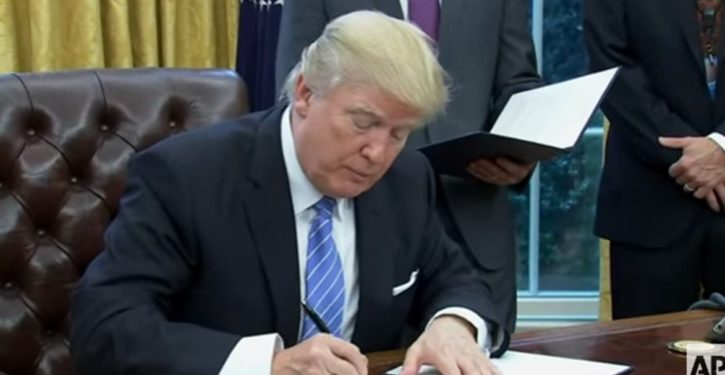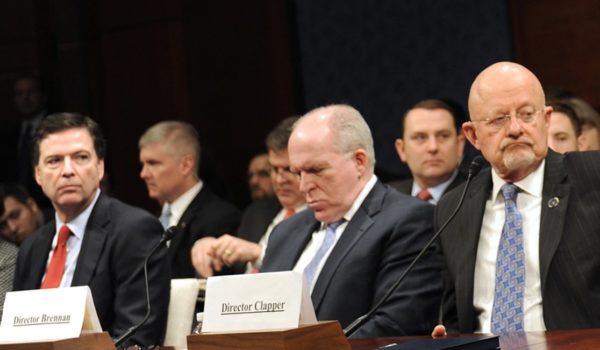
[Be sure to see the essential addendum at the bottom. – J.E.]
As Howard Portnoy noted earlier today, the Trump administration announced the president would sign an executive order aimed at ending family separations. The media crowed quickly that Trump was backing down on the “zero tolerance” policy — which Senator Chuck Schumer (D-NY) had made clear on Tuesday was the real goal.
Democrats are not as interested in the fate of children as they are in making sure the adults accompanying them in illegal border crossings are released into the U.S. population without their cases decided. The purpose of structuring law to create untenable situations is to make unprotected borders seem like the only option. This is why Schumer was adamant that fixing the law — which Republicans have two viable bills in progress to do — is not the right solution.
Will this presidential election be the most important in American history?
It turns out, however, that Trump has not ended the zero-tolerance policy, nor will the administration end all separations. According to his executive order, the zero-tolerance policy will continue. CNBC has a summary of the order’s provisions, which I have annotated with comments:
Here’s what the executive order would do, according to text circulated by the White House:
-
It orders Homeland Security Secretary Kirstjen Nielsen “to the extent permitted by law and subject to the availability of appropriations” to keep families together during criminal proceedings. [This was already administration policy.]
-
The measure says the administration does not have to keep families together “when there is a concern” that detaining a child with a parent “would pose a risk to the child’s welfare.” [This was already administration policy.]
-
It directs Attorney General Jeff Sessions to file a request with a federal district court in California to change a legal settlement that curbs the government’s ability to keep children in detention. [This is new, but it’s not what Democrats wanted.]
-
It orders Sessions to prioritize criminal proceedings for cases involving families. [This is new in a formal sense, although anecdotal commentary in news coverage over the last few weeks has suggested it was already informal policy.]
Trump actually didn’t give anything up. The mainstream media are framing this as a big political fail for him. (The Hill helpfully points out that the original version of the executive order misspelled the word “separation.”) I have already heard four different MSM sources, just in the last 15 minutes, proclaim that Trump reversed himself.
But that is categorically untrue: he has not ended “zero tolerance,” and he has not “ended family separations.” The family separation policy has not changed at all from the policy outlined at the DHS website prior to the order.
What Trump did do was “sign an order.” It is even somewhat humorous that he made the exact concession Chuck Schumer demanded on Tuesday: he signed an order. It just doesn’t contain what Schumer wants.
The “punt” in this action is twofold, with both folds putting pressure on Republicans in Congress. One is the directive to Jeff Sessions to file a motion in federal court to change the Flores settlement. Flores is what limits the detention of accompanying adults to the 20 days that children can be held.
This action would be the weakest one in the order, as it is unlikely the 20-day settlement will be voided. Congressional action will be required one way or the other, to ensure the law on border detentions and immigration processing can actually be enforced.
The other punt is found in the title of the order: “Affording Congress an Opportunity to Address Family Separation.”
Trump was clear, and the order is clear, that this is a temporary measure. Trump has not adopted the Obama policy of catch-and-release, as long as you can cross the border with a child in tow. The order is meant to give Congress time to address the need for additional capacity so that it is feasible to enforce border security and immigration law without having to separate children from parents during detention periods.
We’ll see if Congress can do that. If this remains unresolved through the summer, it will not go well for Democrats in November.
I recommend not listening to the tone and emphasis of the MSM coverage. Trump isn’t “backing down” with this order. The media are — sorry, there’s no other word for it — simply lying about what he is doing. This wouldn’t be the first time on this topic; Howard Portnoy pointed out this morning that quite suddenly, the media acknowledge the relevance and meaning of the 1996 immigration law and the Flores decision, which they had previously insisted was either irrelevant, or even non-existent.
Basically, this was a pooch punt by Trump. He’s continuing his defensive game with an unchanged strategy. We’ll see what the Republicans and Democrats in Congress can do — or even want to do — with their four downs.
Addendum: A lot of right-wing commentators are emphasizing the point that the Trump order is “vague” (which I would actually say is less descriptive than “inexplicit”). It’s not written to serve as legally defensible guidance. The order itself may well be struck down quickly by a federal court, because it’s not written to articulate executable policy. All it does it affirm administration priorities, and reiterate selected points from the existing DHS guidance.
I appreciate these hard-working points, but I suggest taking a step back and looking at the bigger picture. Here is the real point:
Trump didn’t write this order to promulgate an executable change in policy.
If you assume he did, your thinking has been duped by your expectations — about what executive orders are signed for — and by the mainstream media theme that Trump has reversed himself. Trump didn’t sign an Obama-type E.O. here, meant to govern execution. He signed an order to (a) punt to Congress, and (b) emphasize his priorities.
Remember, Trump is a tactical communicator. He isn’t necessarily using instruments of communication for the purposes you assume. Will his tactics work? We’ll find out.




